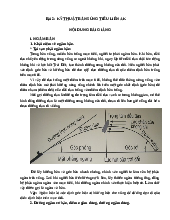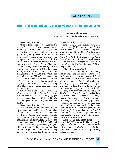



















Preview text:
STRATEGIC PURCHASING PRACTICES
The Case Study of PAUL Bakery UK Phuong Phan 2 Bachelor’s thesis January 2016
Degree in International Business
Major in Green Supply Chain Management ABSTRACT Tampereen ammattikorkeakoulu
Tampere University of Applied Sciences
Degree in International Business
Major in Green Supply Chain Management Phuong Phan
Strategic Sourcing Practices, the case study of PAUL Bakery UK
Bachelor's thesis 44 pages, appendices 2 pages January 2016
Traditionally, purchasing has been considered to be an exchange activity between buy-
ers and sellers for a mutual benefit. To some extent, this is the basic nature of purchas-
ing and it will never be obsolete in a small operations scale. However, the leverage of
strategic purchasing has been gradually recognized by practitioners and researchers over
decades. With an integrated vision, purchasing is no longer a basic function in the or-
ganizational structure. Rather, it is now a potential area to develop in order to optimize
the input performance specifically in inbound logistics and generally in logistics opera-
tions. A strategic development applied in purchasing requires company’s ambition for
establishing long-term relationships with their suppliers, negotiating total cost reduction
and creating value-added features in supplier partnerships.
The commissioner of this thesis is PAUL Bakery UK. It is one of the fastest growing
subsidiaries of PAUL International in France. Operating mostly in London, PAUL UK
has a huge business potential for growth. This is the time when the company seeks for
new improvement in its operational process to keep pace with the market competitive-
ness and support its own expansion. Purchasing at PAUL UK serves mostly for its pro-
duction needs and has not yet been built up to its fullest potential. Thus, new develop-
ment of sourcing methods shall be helpful with some possible applications in the near future.
Key words: Strategic Sourcing Supply Management Proactive Purc
Strategic Purchasing Supplier Relationship Management (SRM 4 CONTENTS
1 INTRODUCTION ....................................................................................................... 5
1.1 The need for the thesis ......................................................................................... 5
1.2 Objectives of thesis .............................................................................................. 6
1.3 Thesis Structure ................................................................................................... 7
2 THEORETICAL FRAMEWORK .............................................................................. 8
2.1 Strategic Purchasing ............................................................................................ 8
2.1.1 Reactive Buying versus Proactive Buying ................................................ 9
2.1.2 Key Purchasing Variables ....................................................................... 12
2.2 Sourcing Strategy and Supplier Relationship Management (SRM) .................. 21
3 RESEARCH METHODS .......................................................................................... 29
3.1 Basic research versus Applied Research............................................................ 29
3.2 Qualitative Method ............................................................................................ 29
3.3 Case study as a reasearch method ...................................................................... 30
3.3.1 Data Collection........................................................................................ 31
3.3.2 Data Analysis .......................................................................................... 31
4 THE CASE STUDY AT PAUL BAKERY UK ........................................................ 32
4.1 Establishment and Operations............................................................................ 32
4.2 Product lines and services offered ..................................................................... 33
4.2.1 PAUL outlets ........................................................................................... 34
4.2.2 PAUL’s wholesale business .................................................................... 34 4.3
Purchase Practice at L’Atelier de PAUL ........................................................... 35
4.3.1 Purchase process ..................................................................................... 35
4.3.2 Challenges acknowledged in Purchase Process ...................................... 36
5 RECOMMENDATION AND CONCLUSION ........................................................ 41
REFERENCES ................................................................................................................ 45
APPENDICES ................................................................................................................ 46
Appendix 1. Results of the interview with Cost and Stock Control Supervisor
at PAUL UK. ..................................................................................................... 46 5 1 INTRODUCTION 1.1 The need for the thesis
In this current competitive economy, all enterprises of all sizes are continuously longing
for a better way to achieve the best performance and deliver the highest value to their
end users with less expenditures. The way toward mastering this goal can be rocky as
not every company has sufficient resources to fully support its strategic movement. Pur-
chasing function is the first gateway for any primary inputs to be filtered for further
movement inside the operational process. The saying “garbage in, garbage out” might
explain briefly the role of supply management in any business. Without proper under-
standing and implementation of this function, firms are more likely to encounter numer-
ous defaults at the other end.
Supply management mainly focuses on strategic purchasing and supplier relationship
management. To be specific, strategic purchasing activates a proactive attitude toward
an organization’s purchasing power and facilitates a win-win sourcing strategy with its
suppliers. Nowadays, even medium sized enterprises have begun to invest in their
sourcing strategies for a more efficient procurement. Purchasing is no longer a low cost
negotiation but rather a value creating commitment. After determining appropriate buy-
ing strategies, companies need proper tools to maintain their supplier relationships. This
is a very essential part of supply management and it is not an easy task. Effective sup-
plier management supports firms to flexibly deal with all the problems occurring during
their partnerships with suppliers. Additionally, purchase department could confidently
make a decision on which relationships should be kept and which ones should be elimi-
nated by applying supplier assessment methods.
For a long time, firms have ignored and underestimated the power of purchasing. Even
though if they have, the full potential of purchasing has not been exploited. This tradi-
tional point of view has received a lot of criticisms lately. Researchers and practitioners
are eagerly seeking for new approaches and techniques in order to improve the draw-
backs of traditional approach.
Applying a strategic mindset into purchasing will not only create smooth goods and
value exchange streams between buyers and sellers but also reduce company’s re-
sources for fixing failures down to the chain. It also strengthens the flexibility and adap- 6
tation of a business for new opportunities and challenges thanks to its strong foundation with its suppliers.
During the author’s study time at Tampere University of Applied Sciences, she has
gained an interest in supply chain management and especially in the field of inbound
logistics. Afterward, the experience as a stock and cost control intern at PAUL UK crys-
talized her firm interest for the field. The author discovered the importance of purchas-
ing in this growing business and an update on strategic sourcing process was needed to
increase the company’s competitive advantages in the current business context. Hence,
the topic: “Strategic Purchasing Practices, the case study of PAUL Bakery UK” was
chosen to be the title of her Bachelor Degree’s thesis. 1.2 Objectives of thesis
The thesis focuses on the purchase process particularly on supplier management at
PAUL Bakery UK. There are three main objectives the author aims to achieve in this final thesis.
Firstly, the author is going to analyze and investigate the current purchasing practices at
PAUL UK in order to detect the potential areas for further development. As mentioned
above, purchasing attitude and supplier relationships will be focused to point out exist- ing challenges.
Next, with the support of her academic knowledge and researches on supply manage-
ment, the author will come up with suitable and relevant applications for each acknowl-
edged challenge for purchase process at PAUL UK. More importantly, the suggested
applications will be proposed under the consideration of retail bakery business context
and London business environment. Modification and adjustment will be implemented if it is needed.
Lastly, the author shall reflect and evaluate the advantages and disadvantages of each
application as there are always two sides of a coin. However, the best suggested applica-
tions would be the ones with more advantages and best situated with PAUL UK’s re-
source and business potential. 7
Questions to be answered in thesis 1.
What is the difference between reactive and proactive purchasing? 2.
Which are the best sourcing strategies for different buying situations in
business-to-business environment? 1.3 Thesis Structure
The thesis is divided into five main chapters. The first chapter is introductory part citing
about the necessity and objective of the case research. Next, the second chapter explains
theoretical framework as a foundation of the whole research process. Following that, the
research methods are introduced in chapter 3. The main part is in chapter 4 with the case
study at PAUL Bakery UK and its purchasing practices findings from the researcher.
Finally, the thesis is ended with recommendation and conclusion for PAUL UK in terms of its purchasing strategies. 8 2 THEORETICAL FRAMEWORK 2.1 Strategic Purchasing
Generally, purchasing is referred to acquiring goods or services at the right price, on
time, at the right quantity, with the right quality and from the right source. Nowadays,
this common sense about purchasing becomes simplistic and superficial. Eventually, all
buyers should question the illusion of what exactly the right price or the right source is.
Our business world is changing with the speed of light and things fluctuate second by
second. Hence setting stable and rigid standards for procurement is no longer potent for
many enterprises. Baily et al. (2005, 4) suggest a broader description of purchasing’s objectives:
To fulfil an organization’s needs by supply a good flow of materials and ser- vices.
To ensure continuity of supply by maintaining effective relationships with exist-
ing sources and by developing other sources of supply either as alternatives or to
meet emerging or planned needs.
To buy efficiently and wisely; and acquire the best value for every dollar spent.
To build a co-operative relationship with other departments and to spread out
necessary information and advices in order to operate as a whole.
To develop a combination of resources such as staff, policies, procedures and
organization to achieve these above objectives.
Additionally, the objectives might include:
To select the best suppliers in the market.
To support the development of new products.
To protect the company’s cost structure.
To maintain the correct quality/value balance.
To monitor supply market trend.
To negotiate effectively with suppliers for win-win relationships.
To approach supply management environment-responsibly. 9
As can be seen from these objectives mentioned above, purchasing is not simply a series
of transactional and administrative activities. Modern perception toward purchasing is a
strategic function for resources management and development. Purchase strategists have
always been aiming to achieve economics and strategic congruence in purchase depart- ment with its company.
The importance of purchasing was declared by a phrase “a 1 percent saving in purchas-
ing is equal to a 10 percent increase in sales” in early 1980s (Baily et al. 2005, 8). A
firm can possibly increase its profits by investing in an efficient purchase practice in-
stead of stimulating sales. This point of view totally shifts a company’s value system
around and by mastering their purchase process, firms can acquire a tremendous value
in terms of internal operational and financial management. In addition, it is said that on
average 60 percent of every sales dollar goes towards material cost (Tiersten 1989, 21).
This shows that not only from the saving perspective but the cost structure of a product
depends very much on raw material costs and purchasing activities. Thus, the role of
strategic purchasing is never being overrated.
2.1.1 Reactive Buying versus Proactive Buying
In mid-1970s, purchasing was seen as an administrative function rather than a strategic
function. Purchase played a passive role in organizational structure and was operated in
an isolated environment rather than an integrated supply chain (Cousins et al. 2007, 12.)
The new term Supply Chain Management, developed in 1990s, has changed the way
purchasing interacts with suppliers and other departments organizations. One of the new
term in purchase process nowadays is Proactive Buying (Davies et al. 2004, 12). Appar-
ently, it is a revolutionary term to avoid the drawbacks of reactive approach in purchas-
ing and widely in Supply Chain Management.
Reactive Buying is seen as a transactional relationship between buyers and suppliers. It
is an exchange of goods or services for a certain amount of money. This point of view is
still an appropriate for small businesses which aimed for low-cost items in a limited
amount of time. However, the mutual relationship between buyers and sellers is empha-
sized significantly lately in many organizations due to its great benefits. Proactive buy-
ing approach not only creates trustful and dynamic relationships with suppliers but also
it actively interacts with other departments and works closely with the end goals of the 10
organizations. This is a suitable approach to eliminate the incongruence between indi-
vidual function’s visions towards the company’s vision. Moreover, as it is mentioned in
the table 1, proactive buying requires a firm to have its own purchase department and
that department is in charge of generating product specifications. It is the matter of trust
within a company and senior managers to let this department to be in charge of such an
important thing. While reactive buying receives all the specifications from marketing
and production department, proactive buying gives purchase department a bigger chal-
lenge to deal with. Since purchase department knows the input performance the best, it
is more relevant to turn the information stream the other way around and let purchase
department take the front seat. Of course communication needs to be set among pur-
chase department and other departments and senior management levels before any deci-
sions are made but from the contemplative view, purchase department has an active role
for product specifications after all.
Another common myth about strategic buying is that it is a function only to filter defec-
tive materials and goods. Obviously purchase function played an administrative and
detective role before. Nowadays, it is a function to manage and reduce technical risks
and defective supplies of input performance. The function has a wider reach to its sup-
pliers more than just ordering and detecting activities.
In many big firms where purchasing management is highly required, it is very important
to have an integrated database with major suppliers. Most firms nowadays use Material
Requirement Planning (MRP), Enterprise Resource Planning (ERP) or Systems, Appli-
cations and Products (SAP) as internal integrated management systems to better super-
vise their supply chain. In inbound logistics, these systems assist purchase department
to analyse the goods flow and inventory level as well as specify product features for
buying. By using either of these two systems, enterprises are more likely to exchange
information with its suppliers and reduce the procurement’s lead time. Apparently, good
suppliers are the ones who have already mastered their internal informational system as
well. Therefore; there is an equal clarity level between buyers and suppliers. This is
when a great and dynamic partnership blossoms. In addition, a typical challenge that
traditional purchasing has always been encountering is “bull whip - effect”. Generally,
bull-whip effect is caused by a failure in demand forecast and distorted informational
amplification from outbound logistics back to inbound logistics in supply chain. Pur-
chase department is not usually aware of this effect and it leads to huge unnecessary




